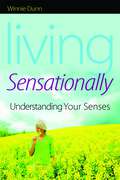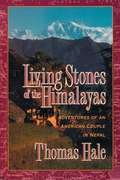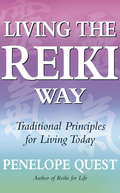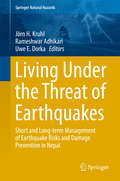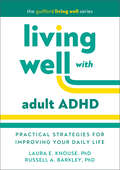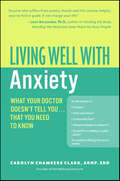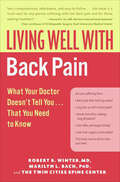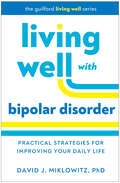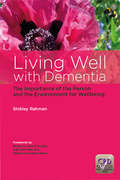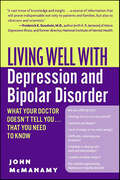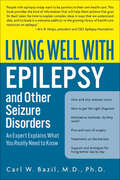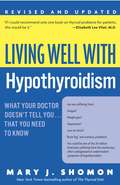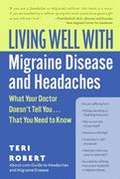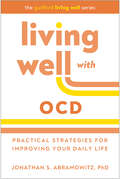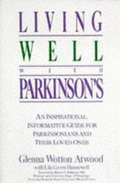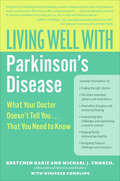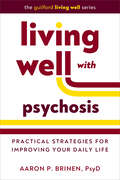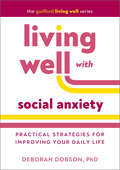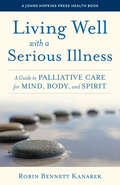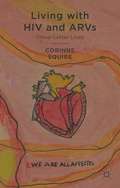- Table View
- List View
Living Sensationally: Understanding Your Senses
by Winnie DunnHow do you feel when you bite into a pear... wear a feather boa... stand in a noisy auditorium... or look for a friend in a crowd? Living Sensationally explains how people's individual sensory patterns affect the way we react to everything that happens to us throughout the day. Some people will adore the grainy texture of a pear, while others will shudder at the idea of this texture in their mouths. Touching a feather boa will be fun and luxurious to some, and others will bristle at the idea of all those feathers brushing on the skin. Noisy, busy environments will energize some people, and will overwhelm others. The author identifies four major sensory types: Seekers; Bystanders; Avoiders and Sensors. Readers can use the questionnaire to find their own patterns and the patterns of those around them, and can benefit from practical sensory ideas for individuals, families and businesses. Armed with the information in Living Sensationally, people will be able to pick just the right kind of clothing, job and home and know why they are making such choices.
Living Stones of the Himalayas: Adventures of an American Couple in Nepal
by Thomas HaleSince 1970, the team of Thomas Hale and his wife, Cynthia, have struggled to serve God as medical doctors in the remote storybook kingdom of Nepal. In the process they have experienced both the hardships and the blessings of bringing Western medicine to people who distrust -- even fear -- ideas differing from their own. n the same process, by their selfless love and caring, they have gained the affection and trust of their Nepali patients and neighbors. In this true story, the faith and humility of doctors Tom and Cynthia Hale are matched by the beguiling personality and character of the Nepalese people, the majority of whom are subsistence farmers who share much in common with the poor of all developing countries. Living Stones of the Himalayas, like its predecessors Don't Let the Goats Eat the Loquat Trees and On the Far Side of Liglig Mountain, is a graphic portrait of the human condition and the growing pains of the unique and intriguing land of Nepal with its astonishing beauty that exists side by side with: - faith and superstition - sickness and death - ancient traditions and twentieth-century innovations - courage and joie de vivre Living Stones of the Himalayas is a fascinating account of everyday and sometimes incredible experiences mingled with humor, understanding, and love for humanity. Reading it will transport you to one of the most enchanting lands away -- first class.
Living The Reiki Way: Traditional principles for living today
by Penelope QuestPractising Reiki is not simply about healing others - it is also about healing yourself and growing spiritually. In LIVING THE REIKI WAY, Penelope Quest offers practical and spiritual guidance on how you can absorb the six key Reiki principles into your everyday life. They are:* Live in the now* Live without anger* Live without worry* Live with gratitude* Live with kindness* Work honestly and diligentlyBy encouraging us to live by these principles in the present, Penelope Quest will help us to achieve long-term happiness and contentment.
Living Under the Threat of Earthquakes: Short and Long-term Management of Earthquake Risks and Damage Prevention in Nepal (Springer Natural Hazards)
by Rameshwar Adhikari Jörn H. Kruhl Uwe E. DorkaThis book addresses earthquakes, with a special focus on the Ghorka earthquake, which struck parts of central Nepal in April 2015. Drawing on this disastrous event, it closely examines various aspects of earthquakes in contributions prepared by international experts. The topics covered include: the geological and geophysical background of seismicity; a detailed inventory of the damage done by the earthquake; effective damage prevention through earthquake-safe buildings and settlements; restoration options for world-heritage buildings; strategies for providing technical and medical relief and, lastly, questions associated with public life and economy in a high-risk seismic zone. Combining perspectives from various fields, the book presents the state of the art in all earthquake-related fields and outlines future approaches to risk identification, damage prevention, and disaster management in all parts of society, administration, and politics in Nepal. Beyond the specific disaster in Nepal, the findings presented here will have broader implications for how societies can best deal with disasters.
Living Well with Adult ADHD: Practical Strategies for Improving Your Daily Life (The Guilford Living Well Series)
by Russell A. Barkley Laura E. KnouseImagine an ADHD toolkit filled with tried-and-true skills that empower you to be more focused and productive--and to "hack" daily life so your strengths can shine. That's exactly what expert therapist Laura E. Knouse and preeminent authority Russell A. Barkley offer in this friendly guide. In short, engaging chapters, you get a menu of science-based strategies and resources for getting organized, completing tasks from start to finish, managing time, regulating your emotions and impulses, and addressing common relationship problems faced by adults with ADHD. Drs. Knouse and Barkley share ideas you can use every day, complete with checklists, self-coaching tips, helpful links, and downloadable forms.
Living Well with Anxiety: What Your Doctor Doesn't Tell You . . . That You Need to Know (Living Well)
by Carolyn Chambers ClarkA complete guide to the side-effects and treatments for anxiety disordersHigh anxiety is an unfortunate byproduct of this world, and for approximately 20 million American adults a year, anxiety becomes a debilitating part of their lives. The psychological can become physical, causing dizziness, stammering, heart palpitations, trembling, shaking, and other symptoms. Unlike other books on anxiety disorders, Living Well with Anxiety offers a holistic approach to minimizing anxiety, presenting both conventional psychiatric and psychological approaches to anxiety conditions, as well as patient anecdotes, and nutrition, herbal, environmental, exercise and other healing measures to combat this disorder. Living Well with Anxiety contains helpful advice for a wide range of anxiety disorders, including social anxiety disorder, panic disorder, obsessive compulsive disorder and various phobias that cause anxiety. With a comprehensive resource section that contains websites, doctors, and helpful articles, this book, like all of the titles in the successful Living Well series, offers positive and far-reaching solutions to building a healthier life, both emotionally and physically.
Living Well with Back Pain: What Your Doctor Doesn't Tell You . . . That You Need to Know
by Marilyn L. Bach Robert B. Winter Twin Cities Spine CenterIf you're one of the millions of Americans suffering from back pain, Robert B. Winter, MD, and Marilyn L. Bach, PhD, have the answers and knowledge you need to effectively manage your condition. In Living Well with Back Pain, Winter and Bach draw on an extensive network of experts to bring you the latest information on:Diagnosing—and even eliminating—the problemExercise programs and over-the-counter drug treatmentsChoosing the right medical practitionerWhen surgery and other invasive procedures are not neededThe authors are affiliated with an internationally renowned back treatment center, the Twin Cities Spine Center, which has treated tens of thousands of back pain sufferers. Their expertise and up-to-the-minute knowledge make this the most comprehensive, current, and accessible back pain book available.
Living Well with Bipolar Disorder: Practical Strategies for Improving Your Daily Life (Guilford Living Well Series)
by David J. MiklowitzWhat does it take to achieve a successful career, healthy habits, and fulfilling relationships--even with bipolar disorder (BD)? What common stressors do you need to look out for, and how can you cope with them? No one is better suited to provide people with BD with practical problem-solving help than leading expert David J. Miklowitz. From managing mood swings to dealing with anxiety, getting enough sleep, defusing family conflicts, and troubleshooting medications, this book offers keys to effective self-care. Short, clearly formatted chapters with downloadable practical tools help you tackle challenges as they arise and plan for trouble spots that lie ahead. With Dr. Miklowitz's empowering guidance, navigate your own unique path to living well.
Living Well with Chronic Illness
by Committee on Living Well Chronic Disease: Public Action to Reduce Disability Improve Functioning Quality Of LifeIn the United States, chronic diseases currently account for 70 percent of all deaths, and close to 48 million Americans report a disability related to a chronic condition. Today, about one in four Americans have multiple diseases and the prevalence and burden of chronic disease in the elderly and racial/ethnic minorities are notably disproportionate. Chronic disease has now emerged as a major public health problem and it threatens not only population health, but our social and economic welfare. Living Well with Chronic Disease identifies the population-based public health actions that can help reduce disability and improve functioning and quality of life among individuals who are at risk of developing a chronic disease and those with one or more diseases. The book recommends that all major federally funded programmatic and research initiatives in health include an evaluation on health-related quality of life and functional status. Also, the book recommends increasing support for implementation research on how to disseminate effective longterm lifestyle interventions in community-based settings that improve living well with chronic disease. Living Well with Chronic Disease uses three frameworks and considers diseases such as heart disease and stroke, diabetes, depression, and respiratory problems. The book's recommendations will inform policy makers concerned with health reform in public- and private-sectors and also managers of communitybased and public-health intervention programs, private and public research funders, and patients living with one or more chronic conditions.
Living Well with Dementia: The Importance of the Person and the Environment for Wellbeing
by Shibley RahmanThis unique guide provides a much needed overview of dementia care. With a strong focus on the importance of patients and families, it explores the multifaceted meaning behind patient wellbeing and its vital significance in the context of national policy.Adopting a positive, evidence-based approach, the book dispels the bleak outlook on dementia ma
Living Well with Depression and Bipolar Disorder: What Your Doctor Doesn't Tell You . . . That You Need to Know
by John McManamySeven years ago, John McManamy was diagnosed with bipolar disorder. Through his successful Web site and newsletter, he has turned his struggles into a lifelong dedication to helping others battling depression and bipolar disorder reclaim their lives. In Living Well with Depression and Bipolar Disorder, he brilliantly blends the knowledge of leading expert authorities with the experiences of his fellow patients, as well as his own, and offers extensive information on:Diagnosing the problemAssociated illnesses and symptomsTreatments, lifestyle, and copingThe effects of depression and bipolar disorder on relationships and sexWith a compassionate and eloquent voice, McManamy describes his belief that depression is a wide spectrum that reaches from occasional bouts of depression to full-fledged bipolar disorder. The first book to help patients recognize this diversity of the disorder, Living Well with Depression and Bipolar Disorder will help sufferers begin to reclaim their lives.
Living Well with Epilepsy and Other Seizure Disorders: An Expert Explains What You Really Need to Know
by Carl W. BazilOffering treatment options, lifestyle strategies and support, this expert health care resource for people living with epilepsy is “a welcome addition” (Eric R. Hargis, President & CEO, Epilepsy Foundation). Epilepsy, once mistakenly associated with demonic possession, has for centuries been a poorly understood illness. Today, though it affects nearly one out of every one hundred Americans, little comprehensive information can be found on bookshelves regarding this common and complex neurological disease. Until now.Using his expertise in pharmacology and neuroscience, Dr. Carl Bazil demystifies epilepsy and other seizure disorders and offers medical, practical, and emotional support to patients and their families. He explains how and why seizures occur, and thoroughly discusses treatment options, the pros and cons of surgery, experimental and alternative treatments, strategies for daily living, and much more.Substantiated with case examples, this useful book provides a much-needed window into epilepsy so that patients can achieve the full life they deserve.
Living Well with Hypothyroidism
by Mary J. ShomonThe Most Comprehensive Resource Available on the Diagnosis and Treatment of Hypothyroidism For millions of Americans, hypothyroidism often goes untreated ... or is treated improperly. This book, thoroughly researched by the nation's top thyroid patient advocate--a hypothyroidism patient herself--provides you with answers to all your questions, including: What is hypothyroidism? What are the warning signs, symptoms, and risk factors? Why is getting diagnosed often a challenge, and how can you overcome the obstacles? What treatments are available (including those your doctor hasn't told you about)? Which alternative and holistic therapies, nutritional changes, and supplements may help treat hypothyroidism?
Living Well with Hypothyroidism
by Mary J. ShomonThe Most Comprehensive Resource Available on the Diagnosis and Treatment of HypothyroidismFor millions of Americans, hypothyroidism often goes untreated ... or is treated improperly. This book, thoroughly researched by the nation's top thyroid patient advocate--a hypothyroidism patient herself--provides you with answers to all your questions, including:What is hypothyroidism?What are the warning signs, symptoms, and risk factors?Why is getting diagnosed often a challenge, and how can you overcome the obstacles?What treatments are available (including those your doctor hasn't told you about)?Which alternative and holistic therapies, nutritional changes, and supplements may help treat hypothyroidism?
Living Well with Hypothyroidism
by Mary J. ShomonThe Most Comprehensive Resource Available on the Diagnosis and Treatment of HypothyroidismFor millions of Americans, hypothyroidism often goes untreated ... or is treated improperly. This book, thoroughly researched by the nation's top thyroid patient advocate--a hypothyroidism patient herself--provides you with answers to all your questions, including:What is hypothyroidism?What are the warning signs, symptoms, and risk factors?Why is getting diagnosed often a challenge, and how can you overcome the obstacles?What treatments are available (including those your doctor hasn't told you about)?Which alternative and holistic therapies, nutritional changes, and supplements may help treat hypothyroidism?
Living Well with Migraine Disease and Headaches: What Your Doctor Doesn't Tell You... That You Need to Know
by Teri RobertFor millions of Americans, Migraine disease, tension headaches, and other headaches are a debilitating part of every day. Teri Robert has been there -- in fact, she experienced her first Migraine at age six. Now, in this groundbreaking holistic guide to the diagnosis and treatment of headaches and Migraine disease, she brings a patient-empowering message to all headache sufferers: you don't have to live with daily pain. She provides you with all the information you need to know about getting the help you need, including: Understanding side effects Treatments for long-term relief Risks and symptoms, Identification of the various types of headaches, Traditional and alternative therapies, Information on finding health care practitioners and support, Numerous case studies and expert advice.
Living Well with OCD: Practical Strategies for Improving Your Daily Life (Guilford Living Well Series)
by Jonathan S. AbramowitzOver decades, noted authority Jonathan S. Abramowitz has helped thousands of people use the best science-based strategies to overcome obsessive–compulsive disorder (OCD). But if you have OCD--whether in treatment or not--you know that some days are harder than others. If you are looking for empathic support to navigate the rough patches when OCD disrupts your life, this book is for you! Get step-by-step ideas and downloadable practical tools for coping with lingering obsessional thoughts and doubts, riding out compulsive urges, and staying on track at work or in school. Dr. Abramowitz offers tips for navigating relationships and solving problems with family members, friends, and romantic partners. In short, engaging chapters, this book helps you cultivate resilience, replace self-criticism with self-compassion, and build the life you want--even with OCD.
Living Well with Parkinson's
by Glenna Wotton Atwood Lila Green HunnewellPractical suggestions for everyday living, nutrition, exercise, attitude, dealing with doctors, medications, therapies, support grou Oneps, organizations in the US and Canada. One of the authors has Parkinson's and tells of her own experiences. No profanity or violence. No explicit sexual words.
Living Well with Parkinson's Disease: What Your Doctor Doesn't Tell You....That You Need to Know
by Winifred Conkling Michael J. ChurchA complete guide to Parkinson’s from two people with the disease who cofounded a national support and advocacy organization.In Living Well with Parkinson’s Disease, Gretchen Garie and Michael J. Church, a couple who both have Parkinson’s and live daily with the effects of the disease, thoroughly discuss diagnosis, treatment options, and the emotional consequences of this difficult illness. With a conversational, pragmatic, and personal tone, they offer advice on such topics as:How Parkinson’s disease affects relationshipsThe role of diet, supplements, and rest and relaxationStrategies for navigating professional life and the maze of the health-care systemHandling everyday challenges such as buttoning a shirt or rolling over in bedAnd more!Compassionate and inspiring, Living Well with Parkinson’s Disease offers knowledge and wisdom from those who understand the challenges of dealing with Parkinson’s every day.“[Gretchen and Michael’s] firsthand knowledge as patients, coupled with their years of experience as experts and advocates, allow them to offer a unique perspective. Using the information provided by Gretchen and Michael in this book, you, too, can live well with Parkinson’s disease.” —John D. Campbell, MD, neurologist and medical director for PASFL, the Parkinson’s Association of Southwest Florida
Living Well with Psychosis: Practical Strategies for Improving Your Daily Life (The Guilford Living Well Series)
by Aaron P. BrinenFor people with psychosis, recovery is a winding path, not a straight line. And the best person to steer your recovery is you. Leading psychologist Aaron P. Brinen busts myths and helps you build the life you want in this empowering book. Dr. Brinen provides step-by-step guidance for becoming a strong self-advocate, navigating treatment options, managing symptoms that cause distress, and coping with stigma. Learn crucial ways to connect with others, pursue your goals at school or work, and keep your body healthy. The brief chapters are warm and compassionate, with downloadable practical tools designed to boost your energy and motivation for getting out into the world. This is a book you can read cover to cover--or dip into any time you need extra support to live well and feel good.
Living Well with Social Anxiety: Practical Strategies for Improving Your Daily Life (The Guilford Living Well Series)
by Deborah DobsonIf you have social anxiety, change is hard, and making it stick can be even harder. In this empathic guide, psychologist and anxiety expert Deborah Dobson helps you better understand social anxiety and get out into the world with more confidence. The book is packed with ideas and tips for approaching frequently avoided situations--from making small talk to public speaking to asking someone on a date--one manageable step at a time. Concise, encouraging chapters feature vivid stories, examples, and downloadable practical tools. Dive into this book cover to cover or turn to it when specific problems arise. Getting out of your comfort zone is scary and will feel risky, but it opens up new pathways to the life you really want.
Living Well with Type 2 Diabetes: A Whole Person Understanding and Approach (Living Well)
by Pamela Myles-Hooton Dr John GedneyA practical, self-help guide for living well with Type 2 Diabetes (T2D) In the last forty years, we have seen an astounding rise in the prevalence of T2D in most countries. There are thought to be close to half a billion people affected worldwide. Traditionally thought of as a disease of mid-life and old age, both T2D and the metabolic markers of future disease are now increasingly being seen in young people, children and even infants. The burden of this disease is huge at all levels − for healthcare spend and for added risk of other medical problems. Other than its physical impacts, more than a third of people with T2D are said to experience psychological problems related specifically to the condition. We are now at a crossroads in understanding the science behind T2D with a more focused approach emerging. Research and practice are challenging the traditional way in which we approach and manage T2D − as well as better understanding how to prevent it altogether. By following the advice in this book, you will: · Better understand and be empowered to control your metabolic health · Learn how to prevent, reverse, or improve, and better manage your T2D Living Well self-help guides use clinically proven techniques to treat long-standing and disabling conditions, both psychological and physical.
Living Well with Type 2 Diabetes: A Whole Person Understanding and Approach (Living Well)
by Pamela Myles-Hooton Dr John GedneyA practical, self-help guide for living well with Type 2 Diabetes (T2D) In the last forty years, we have seen an astounding rise in the prevalence of T2D in most countries. There are thought to be close to half a billion people affected worldwide. Traditionally thought of as a disease of mid-life and old age, both T2D and the metabolic markers of future disease are now increasingly being seen in young people, children and even infants. The burden of this disease is huge at all levels − for healthcare spend and for added risk of other medical problems. Other than its physical impacts, more than a third of people with T2D are said to experience psychological problems related specifically to the condition. We are now at a crossroads in understanding the science behind T2D with a more focused approach emerging. Research and practice are challenging the traditional way in which we approach and manage T2D − as well as better understanding how to prevent it altogether. By following the advice in this book, you will: · Better understand and be empowered to control your metabolic health · Learn how to prevent, reverse, or improve, and better manage your T2D Living Well self-help guides use clinically proven techniques to treat long-standing and disabling conditions, both psychological and physical.
Living Well with a Serious Illness: A Guide to Palliative Care for Mind, Body, and Spirit (A Johns Hopkins Press Health Book)
by Robin Bennett KanarekA practical guide for understanding how palliative care can improve quality of life for patients and their caregivers.Robin Bennett Kanarek was a registered nurse working with patients suffering from chronic medical conditions when her ten-year-old son was diagnosed with leukemia. As her son endured grueling treatments, Robin realized how often medical professionals overlook critical psychological, emotional, and spiritual support for people with life-threatening illnesses. Living Well with a Serious Illness is the culmination of decades of Robin's work to advance the field of palliative care.Although palliative care is often associated with hospice and end-of-life planning, Kanarek argues for a more expanded definition that incorporates palliative care earlier in patients' journeys. Living Well with a Serious Illness helps patients and their caregivers understand• what palliative care entails• how to access the support they need when going through a serious illness• what questions to ask medical professionals • how to navigate advanced care planning• definitions of common terminology used with end-of-life planning• the importance of spiritual care, coping strategies, and emotional support• how to become an advocate for palliative careThis book illuminates the importance of seeing patients as individuals who can benefit from care for their body, mind, and spirit—the core tenet of palliative care.
Living With Hiv And Arvs
by Corinne SquireThis book explores the possibilities and difficulties of living with HIV and ARVs, or antiretroviral treatment, today. It draws on HIV-positive people's stories from both the UK and the South African epidemics and offers a deep understanding of the continuing difficulties of living with HIV and the effective strategies for coping that have evolved.
